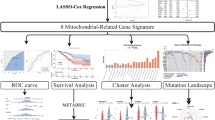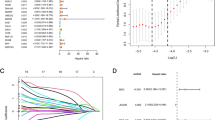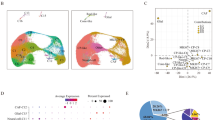Abstract
Retinoblastoma (RB) protein inactivation during tumor progression is often associated with acquisition of immature phenotypes and resistance to therapy. Determination of an RB inactivation signature in a context of gaining undifferentiated phenotype in a p53-null sarcoma system revealed a critical role for interleukin (IL)-6. Using a Gene Set Enrichment Analysis (GSEA), we discovered that poorly differentiated breast cancers are enriched for this RB inactivation signature. Accelerated IL-6 secretion following RB inactivation in an RB-intact luminal-type breast cancer cell line MCF-7 promoted a positive feed forward loop between IL-6 and STAT3 driving tumor growth and endocrine therapy resistance. In addition, some of RB-intact basal-like type breast cancer cell lines exhibited a similar phenotype following RB depletion. The mechanism whereby RB inactivation increases IL-6 production in MCF-7 cells appeared to involve fatty acid oxidation (FAO)-dependent mitochondrial metabolism and c-Jun NH(2)-terminal kinase (JNK). In addition, IL-6, via STAT3-mediated feedback to mitochondria, autonomously adjusts mitochondrial superoxide to levels suitable to maintain stem cell-like activity. The gene expression profile of luminal-type breast cancer patients with low RB expression revealed high enrichment of genes involved in mitochondrial respiration and downstream targets of IL-6. These findings unveiled an unexpected strategy whereby RB suppresses malignant features of cancer cells through metabolic reprogramming and cell-autonomous inflammation.
This is a preview of subscription content, access via your institution
Access options
Subscribe to this journal
Receive 50 print issues and online access
$259.00 per year
only $5.18 per issue
Buy this article
- Purchase on SpringerLink
- Instant access to full article PDF
Prices may be subject to local taxes which are calculated during checkout






Similar content being viewed by others
References
Burkhart DL, Sage J . Cellular mechanisms of tumour suppression by the retinoblastoma gene. Nat Rev Cancer 2008; 8: 671–682.
Knudsen ES, Knudsen KE . Tailoring to RB: tumour suppressor status and therapeutic response. Nat Rev Cancer 2008; 8: 714–724.
Viatour P, Sage J . Newly identified aspects of tumor suppression by RB. Dis Models Mech 2011; 4: 581–585.
Cancer Genome Atlas N.. Comprehensive molecular portraits of human breast tumours. Nature 2012; 490: 61–70.
Gauthier ML, Berman HK, Miller C, Kozakeiwicz K, Chew K, Moore D et al. Abrogated response to cellular stress identifies DCIS associated with subsequent tumor events and defines basal-like breast tumors. Cancer Cell 2007; 12: 479–491.
Herschkowitz JI, He X, Fan C, Perou CM . The functional loss of the retinoblastoma tumour suppressor is a common event in basal-like and luminal B breast carcinomas. Breast Cancer Res 2008; 10: R75.
Bosco EE, Wang Y, Xu H, Zilfou JT, Knudsen KE, Aronow BJ et al. The retinoblastoma tumor suppressor modifies the therapeutic response of breast cancer. J Clin Invest 2007; 117: 218–228.
Jiang Z, Jones R, Liu JC, Deng T, Robinson T, Chung PED et al. RB1 and p53 at the crossroad of EMT and triple-negative breast cancer. Cell Cycle 2014; 10: 1563–1570.
Lim E, Vaillant F, Wu D, Forrest NC, Pal B, Hart AH et al. Aberrant luminal progenitors as the candidate target population for basal tumor development in BRCA1 mutation carriers. Nat Med 2009; 15: 907–913.
Visvader JE, Stingl J . Mammary stem cells and the differentiation hierarchy: current status and perspectives. Genes Dev 2014; 28: 1143–1158.
Chavey C, Bibeau F, Gourgou-Bourgade S, Burlinchon S, Boissiere F, Laune D et al. Oestrogen receptor negative breast cancers exhibit high cytokine content. Breast Cancer Res 2007; 9: R15.
Korkaya H, Liu S, Wicha MS . Breast cancer stem cells, cytokine networks, and the tumor microenvironment. J Clin Invest 2011; 121: 3804–3809.
Iliopoulos D, Hirsch HA, Wang G, Struhl K . Inducible formation of breast cancer stem cells and their dynamic equilibrium with non-stem cancer cells via IL6 secretion. Proc Natl Acad Sci USA 2011; 108: 1397–1402.
Marotta LL, Almendro V, Marusyk A, Shipitsin M, Schemme J, Walker SR et al. The JAK2/STAT3 signaling pathway is required for growth of CD44(+)CD24(-) stem cell-like breast cancer cells in human tumors. J Clin Invest 2011; 121: 2723–2735.
Liu Y, Clem B, Zuba-Surma EK, El-Naggar S, Telang S, Jenson AB et al. Mouse fibroblasts lacking RB1 function form spheres and undergo reprogramming to a cancer stem cell phenotype. Cell Stem Cell 2009; 4: 336–347.
Pajcini KV, Corbel SY, Sage J, Pomerantz JH, Blau HM . Transient inactivation of Rb and ARF yields regenerative cells from postmitotic mammalian muscle. Cell Stem Cell 2010; 7: 198–213.
Sage J . The retinoblastoma tumor suppressor and stem cell biology. Genes Dev 2012; 26: 1409–1420.
Li F, He Z, Shen J, Huang Q, Li W, Liu X et al. Apoptotic caspases regulate induction of iPSCs from human fibroblasts. Cell Stem Cell 2010; 7: 508–520.
Kareta MS, Gorges LL, Hafeez S, Benayoun BA, Marro S, Zmoos AF et al. Inhibition of pluripotency networks by the rb tumor suppressor restricts reprogramming and tumorigenesis. Cell Stem Cell 2015; 16: 39–50.
Takahashi C, Sasaki N, Kitajima S . Twists in views on RB functions in cellular signaling, metabolism and stem cells. Cancer Sci 2012; 103: 1182–1188.
Shamma A, Takegami Y, Miki T, Kitajima S, Noda M, Obara T et al. Rb Regulates DNA damage response and cellular senescence through E2F-dependent suppression of N-ras isoprenylation. Cancer Cell 2009; 15: 255–269.
Shamma A, Suzuki M, Hayashi N, Kobayashi M, Sasaki N, Nishiuchi T et al. ATM mediates pRB function to control DNMT1 protein stability and DNA methylation. Mol Cell Biol 2013; 33: 3113–3124.
Williams BO, Remington L, Albert DM, Mukai S, Bronson RT, Jacks T . Cooperative tumorigenic effects of germline mutations in Rb and p53. Nat Genet 1994; 7: 480–484.
Harvey M, Vogel H, Lee EY, Bradley A, Donehower LA . Mice deficient in both p53 and Rb develop tumors primarily of endocrine origin. Cancer Res 1995; 55: 1146–1151.
Jiang Z, Deng T, Jones R, Li H, Herschkowitz JI, Liu JC et al. Rb deletion in mouse mammary progenitors induces luminal-B or basal-like/EMT tumor subtypes depending on p53 status. J Clin Invest 2010; 120: 3296–3309.
Calo E, Quintero-Estades JA, Danielian PS, Nedelcu S, Berman SD, Lees JA . Rb regulates fate choice and lineage commitment in vivo. Nature 2010; 466: 1110–1114.
Kitajima S, Kohno S, Kondoh A, Sasaki N, Nishimoto Y, Li F et al. Undifferentiated state induced by Rb-p53 double inactivation in mouse thyroid neuroendocrine cells and embryonic fibroblasts. Stem Cells 2015; 33: 1657–1669.
Choi J, Curtis SJ, Roy DM, Flesken-Nikitin A, Nikitin AY . Local mesenchymal stem/progenitor cells are a preferential target for initiation of adult soft tissue sarcomas associated with p53 and Rb deficiency. Am J Pathol 2010; 177: 2645–2658.
Hinohara K, Kobayashi S, Kanauchi H, Shimizu S, Nishioka K, Tsuji E et al. ErbB receptor tyrosine kinase/NF-kappaB signaling controls mammosphere formation in human breast cancer. Proc Natl Acad Sci USA 2012; 109: 6584–6589.
Sansone P, Ceccarelli C, Berishaj M, Chang Q, Rajasekhar VK, Perna F et al. Self-renewal of CD133(hi) cells by IL6/Notch3 signalling regulates endocrine resistance in metastatic breast cancer. Nat Commun 2016; 7: 10442.
Gough DJ, Corlett A, Schlessinger K, Wegrzyn J, Larner AC, Levy DE . Mitochondrial STAT3 supports Ras-dependent oncogenic transformation. Science 2009; 324: 1713–1716.
Wegrzyn J, Potla R, Chwae YJ, Sepuri NB, Zhang Q, Koeck T et al. Function of mitochondrial Stat3 in cellular respiration. Science 2009; 323: 793–797.
Bulua AC, Simon A, Maddipati R, Pelletier M, Park H, Kim KY et al. Mitochondrial reactive oxygen species promote production of proinflammatory cytokines and are elevated in TNFR1-associated periodic syndrome (TRAPS). J Exp Med 2011; 208: 519–533.
Takebayashi S, Tanaka H, Hino S, Nakatsu Y, Igata T, Sakamoto A et al. Retinoblastoma protein promotes oxidative phosphorylation through upregulation of glycolytic genes in oncogene-induced senescent cells. Aging Cell 2015; 14: 689–697.
Hsieh MC, Das D, Sambandam N, Zhang MQ, Nahle Z . Regulation of the PDK4 isozyme by the Rb-E2F1 complex. J Biol Chem 2008; 283: 27410–27417.
Wang LY, Hung CL, Chen YR, Yang JC, Wang J, Campbell M et al. KDM4A coactivates E2F1 to regulate the PDK-dependent metabolic switch between mitochondrial oxidation and glycolysis. Cell Rep 2016; 16: 3016–3027.
Wruck CJ, Streetz K, Pavic G, Gotz ME, Tohidnezhad M, Brandenburg LO et al. Nrf2 induces interleukin-6 (IL-6) expression via an antioxidant response element within the IL-6 promoter. J Biol Chem 2011; 286: 4493–4499.
Das M, Garlick DS, Greiner DL, Davis RJ . The role of JNK in the development of hepatocellular carcinoma. Genes Dev 2011; 25: 634–645.
Ohsawa S, Sato Y, Enomoto M, Nakamura M, Betsumiya A, Igaki T . Mitochondrial defect drives non-autonomous tumour progression through Hippo signalling in Drosophila. Nature 2012; 490: 547–551.
Croonquist PA, Linden MA, Zhao F, Van Ness BG . Gene profiling of a myeloma cell line reveals similarities and unique signatures among IL-6 response, N-ras-activating mutations, and coculture with bone marrow stromal cells. Blood 2003; 102: 2581–2592.
Knudsen ES, Wang JY . Dual mechanisms for the inhibition of E2F binding to RB by cyclin-dependent kinase-mediated RB phosphorylation. Mol Cell Biol 1997; 17: 5771–5783.
Jones RA, Robinson TJ, Liu JC, Shrestha M, Voisin V, Ju Y et al. RB1 deficiency in triple-negative breast cancer induces mitochondrial protein translation. J Clin Invest 2016; 126: 3739–3757.
Blanchet E, Annicotte JS, Lagarrigue S, Aguilar V, Clape C, Chavey C et al. E2F transcription factor-1 regulates oxidative metabolism. Nat Cell Biol 2011; 13: 1146–1152.
Denechaud PD, Lopez-Mejia IC, Giralt A, Lai Q, Blanchet E, Delacuisine B et al. E2F1 mediates sustained lipogenesis and contributes to hepatic steatosis. J Clin Invest 2016; 126: 137–150.
Ciriello G, Gatza ML, Beck AH, Wilkerson MD, Rhie SK, Pastore A et al. Comprehensive molecular portraits of invasive lobular breast cancer. Cell 2015; 163: 506–519.
Petrov PD, Ribot J, Palou A, Bonet ML . Improved metabolic regulation is associated with retinoblastoma protein gene haploinsufficiency in mice. Am J Physiol Endocrinol Metab 2015; 308: E172–E183.
Petrov PD, Ribot J, Lopez-Mejia IC, Fajas L, Palou A, Bonet ML . Retinoblastoma protein knockdown favors oxidative metabolism and glucose and fatty acid disposal in muscle cells. J Cell Physiol 2016; 231: 708–718.
Carracedo A, Cantley LC, Pandolfi PP . Cancer metabolism: fatty acid oxidation in the limelight. Nat Rev Cancer 2013; 13: 227–232.
Guo DJ, Han JS, Li YS, Liu ZS, Lu SY, Ren HL . In vitro and in vivo antitumor effects of the recombinant immunotoxin IL6(T23)-PE38KDEL in multiple myeloma. Oncol Lett 2012; 4: 311–318.
Korkaya H, Kim GI, Davis A, Malik F, Henry NL, Ithimakin S et al. Activation of an IL6 inflammatory loop mediates trastuzumab resistance in HER2+ breast cancer by expanding the cancer stem cell population. Mol Cell 2012; 47: 570–584.
Barbie TU, Alexe G, Aref AR, Li S, Zhu Z, Zhang X et al. Targeting an IKBKE cytokine network impairs triple-negative breast cancer growth. J Clin Invest 2014; 124: 5411–5423.
Sansone P, Storci G, Tavolari S, Guarnieri T, Giovannini C, Taffurelli M et al. IL-6 triggers malignant features in mammospheres from human ductal breast carcinoma and normal mammary gland. J Clin Invest 2007; 117: 3988–4002.
Zhu Z, Aref AR, Cohoon TJ, Barbie TU, Imamura Y, Yang S et al. Inhibition of KRAS-driven tumorigenicity by interruption of an autocrine cytokine circuit. Cancer Discov 2014; 4: 452–465.
Cuperus R, Leen R, Tytgat GA, Caron HN, van Kuilenburg AB . Fenretinide induces mitochondrial ROS and inhibits the mitochondrial respiratory chain in neuroblastoma. Cell Mol Life Sci 2010; 67: 807–816.
Ishimoto T, Nagano O, Yae T, Tamada M, Motohara T, Oshima H et al. CD44 variant regulates redox status in cancer cells by stabilizing the xCT subunit of system xc(-) and thereby promotes tumor growth. Cancer Cell 2011; 19: 387–400.
Mitsuishi Y, Taguchi K, Kawatani Y, Shibata T, Nukiwa T, Aburatani H et al. Nrf2 redirects glucose and glutamine into anabolic pathways in metabolic reprogramming. Cancer Cell 2012; 22: 66–79.
Viale A, Pettazzoni P, Lyssiotis CA, Ying H, Sanchez N, Marchesini M et al. Oncogene ablation-resistant pancreatic cancer cells depend on mitochondrial function. Nature 2014; 514: 628–632.
Ito K, Carracedo A, Weiss D, Arai F, Ala U, Avigan DE et al. A PML-PPAR-delta pathway for fatty acid oxidation regulates hematopoietic stem cell maintenance. Nat Med 2012; 18: 1350–1358.
Kohno S, Kitajima S, Sasaki N, Takahashi C . Retinoblastoma tumor suppressor functions shared by stem cell and cancer cell strategies. World J Stem Cells 2016; 8: 170–184.
Cam H, Balciunaite E, Blais A, Spektor A, Scarpulla RC, Young R et al. A common set of gene regulatory networks links metabolism and growth inhibition. Mol cell 2004; 16: 399–411.
Nicolay BN, Gameiro PA, Tschop K, Korenjak M, Heilmann AM, Asara JM et al. Loss of RBF1 changes glutamine catabolism. Genes Dev 2013; 27: 182–196.
Reynolds MR, Lane AN, Robertson B, Kemp S, Liu Y, Hill BG et al. Control of glutamine metabolism by the tumor suppressor Rb. Oncogene 2014; 33: 556–566.
Sankaran VG, Orkin SH, Walkley CR . Rb intrinsically promotes erythropoiesis by coupling cell cycle exit with mitochondrial biogenesis. Genes Dev 2008; 22: 463–475.
Ciavarra G, Zacksenhaus E . Rescue of myogenic defects in Rb-deficient cells by inhibition of autophagy or by hypoxia-induced glycolytic shift. J Cell Biol 2010; 191: 291–301.
Varaljai R, Islam AB, Beshiri ML, Rehman J, Lopez-Bigas N . Benevolenskaya7EV. Increased mitochondrial function downstream from KDM5A histone demethylase rescues differentiation in pRB-deficient cells. Genes Dev 2015; 29: 1817–1834.
Nicolay BN, Danielian PS, Kottakis F, Lapek JrJD, Sanidas I, Miles WO et al. Proteomic analysis of pRb loss highlights a signature of decreased mitochondrial oxidative phosphorylation. Genes Dev 2015; 29: 1875–1889.
Tsukada T, Tomooka Y, Takai S, Ueda Y, Nishikawa S, Yagi T et al. Enhanced proliferative potential in culture of cells from p53-deficient mice. Oncogene 1993; 8: 3313–3322.
Kadota K, Nakai Y, Shimizu K . A weighted average difference method for detecting differentially expressed genes from microarray data. Algorithms Mol Biol 2008; 3: 8.
Acknowledgements
We thank Drs T Kitamura, N Mukaida, K Yoshioka and Chugai Pharmaceuticals Co. Ltd. for providing materials, Drs T Baba, K Hinohara, A Hirao, T Hoshii, A Ishimura, K Matsumoto, K Sakai, S Sasaki, T Sato, T Shimamura, T Suzuki and Y Tadokoro for technical instruction, Dr A Ooi for pathological diagnosis, Drs I Ajioka and R Jenkins for critical reading of this manuscript, and Dr C Prives for advice. This work was supported by Funding Program for Next Generation World-Leading Researchers to CT, Grant-in-Aid for Scientific Research to CT, S Kitajima and NS, and Hokuriku Bank Research Grant for Young Scientists to S Kitajima.
Author contributions
CT and SK designed research; SK, AY, SK, FL, SS, NN, YN, NS, HM, YW, TT, NO, FM, HS, TN, YS, KT, NG, MS, OH and TT performed research. CT, SK and AY analyzed data. MME and DAB provided materials and opinion. CT and SK wrote manuscript.
Author information
Authors and Affiliations
Corresponding author
Ethics declarations
Competing interests
The authors declare no conflict of interest.
Additional information
Supplementary Information accompanies this paper on the Oncogene website
Supplementary information
Rights and permissions
About this article
Cite this article
Kitajima, S., Yoshida, A., Kohno, S. et al. The RB–IL-6 axis controls self-renewal and endocrine therapy resistance by fine-tuning mitochondrial activity. Oncogene 36, 5145–5157 (2017). https://doi.org/10.1038/onc.2017.124
Received:
Revised:
Accepted:
Published:
Issue date:
DOI: https://doi.org/10.1038/onc.2017.124
This article is cited by
-
RB1 controls differentiation through positive regulation of phosphoglycerate mutases
Cell Death & Disease (2025)
-
Identification of peripheral blood test parameters predicting the response to palbociclib and endocrine therapy for metastatic breast cancer: a retrospective study in a single institution
Surgery Today (2025)
-
CDK4/6 inhibitors and the pRB-E2F1 axis suppress PVR and PD-L1 expression in triple-negative breast cancer
Oncogenesis (2023)
-
Targeting c-Jun inhibits fatty acid oxidation to overcome tamoxifen resistance in estrogen receptor-positive breast cancer
Cell Death & Disease (2023)
-
SH3RF3 promotes breast cancer stem-like properties via JNK activation and PTX3 upregulation
Nature Communications (2020)



